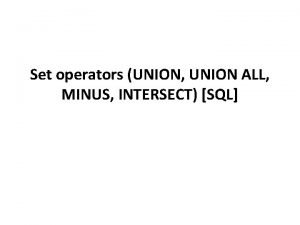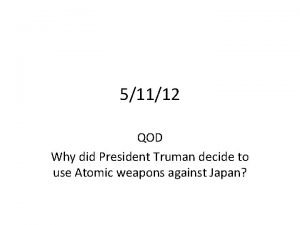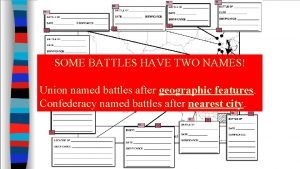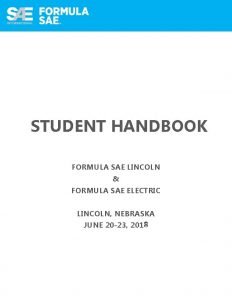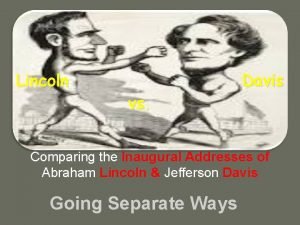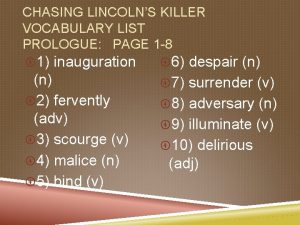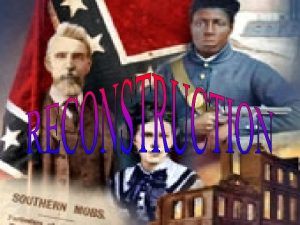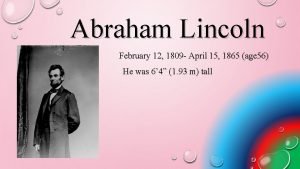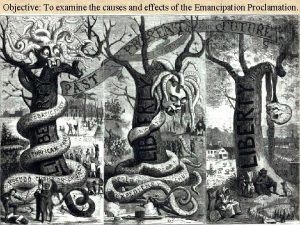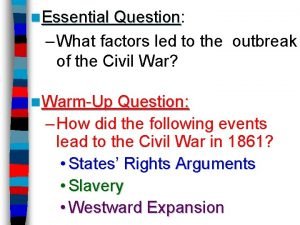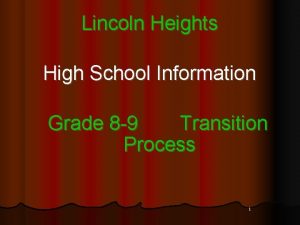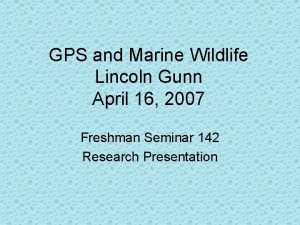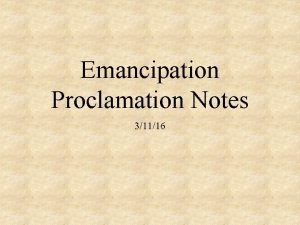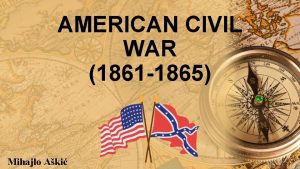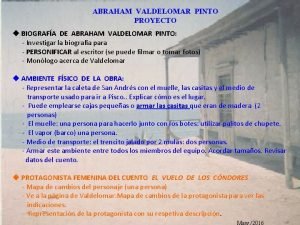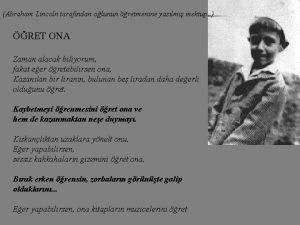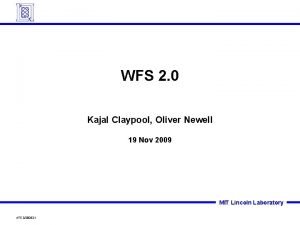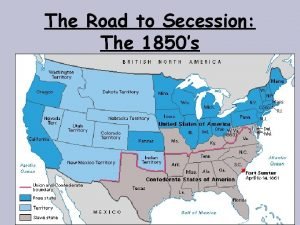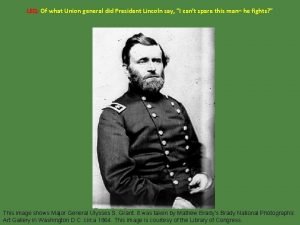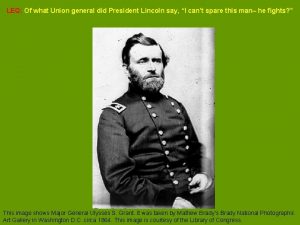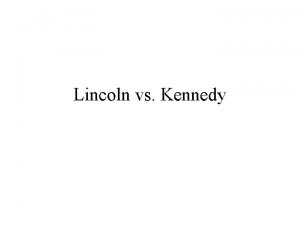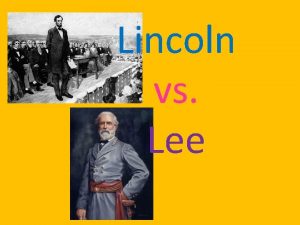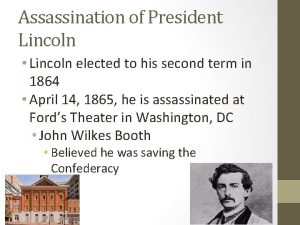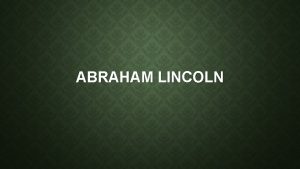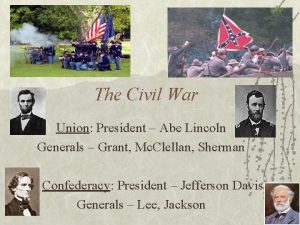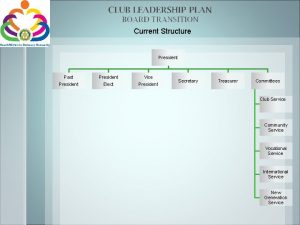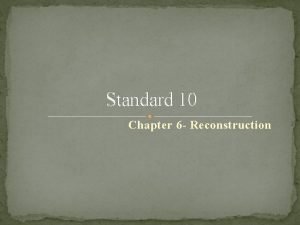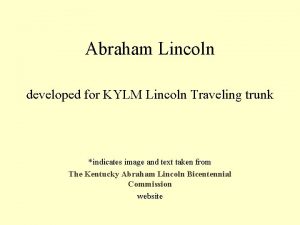LEQ Of what Union general did President Lincoln

















































- Slides: 49

LEQ: Of what Union general did President Lincoln say, “I can’t spare this man– he fights? ” This image shows Major General Ulysses S. Grant. It was taken by Mathew Brady’s Brady National Photographic Art Gallery in Washington D. C. circa 1864. This image is courtesy of the Library of Congress.

LEQ: Of what Union general did President Lincoln say, “I can’t spare this man– he fights? ” Ulysses S. Grant This image shows Major General Ulysses S. Grant. It was taken by Mathew Brady’s Brady National Photographic Art Gallery in Washington D. C. circa 1864. This image is courtesy of the Library of Congress.

The American Civil War’s Western Theater Part 01 This image shows the Hornet’s Nest at the Battle of Shiloh in western Tennessee. This event took place on April 6, 1862. This painting is titled “Battle of Shiloh. ” This painting was created by Thure de Thulstrup (1848 -1930) for L. Prang & Co. circa 1888. This image is courtesy of Wikimedia Commons and of the Library of Congress.

LEQ: Of what Union general did President Lincoln say, “I can’t spare this man– he fights? ” This image shows Major General Ulysses S. Grant. It was taken by Mathew Brady’s Brady National Photographic Art Gallery in Washington D. C. circa 1864. This image is courtesy of the Library of Congress.

LEQ: Of what Union general did President Lincoln say, “I can’t spare this man– he fights? ” Ulysses S. Grant This image shows Major General Ulysses S. Grant. It was taken by Mathew Brady’s Brady National Photographic Art Gallery in Washington D. C. circa 1864. This image is courtesy of the Library of Congress.

Although the Union armies lost battles in the West, they won every major campaign. The Western theater was any area east of Oklahoma that was not in the states of Virginia, Maryland, or Pennsylvania. This image is courtesy of americancivilwar. com.

In little more than two years, the Union cut the Confederacy in two. Cutting the Confederacy in two along the Mississippi River Valley was part of Major General Winfield Scott’s “Anaconda Plan. ” This image is courtesy of law. missouri. edu.

In 1861 the war in the West was devoted to a struggle for control of the border states. In spite of pro-Confederate minorities, both Kentucky and Missouri were cleared of Confederate troops. The border states are shown with a light blue color. This image is courtesy of Wikimedia Commons.

Taking the Mississippi River Valley was a major part of General Winfield Scott’s Anaconda Plan to win the Civil War. In 1862 the Confederacy was squeezed from both the north and the south as both sides fought to control the Mississippi River. This image is courtesy of Wikimedia Commons.

The Union advance began when General Ulysses S. Grant attacked two Confederate forts on the Kentucky-Tennessee border. This map shows Union commanders in blue and Confederate commanders in red. United States General Ulysses S. Grant and the Union navy under Andrew Foote were advancing on Fort Henry on the Tennessee River. Fort Donelson is to the east on the Cumberland River. This image is courtesy of Wikimedia Commons.

The Confederates had built Fort Henry on the Tennessee River. Fort Henry was constructed on low ground along the Tennessee River, and the fort was flooded during the battle. This image by Alexander Simplot is titled “The Capture of Fort Henry. ” This image appeared in the March 1, 1862 edition of Harper’s Weekly. This image is courtesy of the National Park Service.

The Confederates built Fort Donelson on the Cumberland River, and they hoped to stop Union troops from using the rivers to travel south. This image shows the lower river battery at Fort Donelson overlooking the Cumberland River. This image is courtesy of Wikimedia Commons

In February 1862, Grant gathered 15, 000 soldiers and a squadron of ironclad gunboats and captured Fort Henry. Most of the Confederate troops fled to Fort Donelson. Grant and his troops pursued them overland, while the navy went back up the Tennessee River to the Ohio River, and down the Cumberland River. This image is courtesy of thomaslegion. net.

Union gunboats shelled Fort Donelson from the Cumberland River. The next day the Yankees (United States) attacked and surrounded the fort. This image is titled “The Gun-Boat Attack on the Water Batteries at Fort Donelson. ” This image was created by Alexander Simplot for the March 15, 1862 edition of Harpers’ Weekly. This image is courtesy of sonofthesouth. net.

Fort Donelson’s commander, realizing that the fort would soon fall, asked for the best terms of surrender that Grant would accept. The United States (blue) did not completely surround the Confederates. Colonel Nathan Bedford Forrest led approximately 700 of his cavalrymen to the east across Lick Creek and escaped. This image is courtesy of Wikimedia Commons.

Grant replied, “No terms except unconditional and immediate surrender can be accepted. ” In other words, the Rebels had to give up everything. Confederate General Simon Bolivar Bucker (right) expected good terms from Grant. They were friends in the United States Army before the war. When Grant was told he had to resign his army commission in 1854 because of alcoholism, Buckner loaned Grant the money to return home. The image on the left shows Ulysses S. Grant as a Brigadier General in 1861. It is courtesy of Wikimedia Commons. The image of Simon Bolivar Bucker was taken circa 1863. This image is courtesy of the Library of Congress.

Fort Donelson’s commander agreed to Grant’s demand, and about 13, 000 Confederate soldiers surrendered. The Union victory broke the Confederates’ first line of defense in the Mississippi River Valley and opened the South for invasion. The site of the surrender ceremony was the Dover Hotel, located along the Cumberland River in Dover, Tennessee. This image is courtesy of the Library of Congress.

When Northerners heard the news, they celebrated and nicknamed their new hero “Unconditional Surrender” Grant. Our sources state that Harpers’ Weekly did not nickname Grant “Unconditional Surrender” until after the surrender of Vicksburg in 1863. They put Grant on the cover of their July 25, 1863 issue with the words “Unconditional Surrender Grant. ” This image is courtesy of sonofthesouthlnet.

The fall of Fort Donelson opened the way for a Union advance south toward a railroad center at Corinth, Mississippi. This image is titled “Evacuation of Corinth, Mississippi, Lately Held by the Rebel general Beauregard– Burning of Stations, Warehouses and Supplies– Entry of National Troops. This image was created by Henri Lovie for the June 21, 1862 edition of Frank Leslie’s Illustrated Newspaper. This image is courtesy of the Library of Congress.

Grant hoped to capture Corinth, Mississippi, and then planned to move west along the railroad to capture Memphis, Tennessee. Grant planned to move west along the Memphis and Charleston Railroad. This image is courtesy of Wikimedia Commons.

The bloody two-day battle of Shiloh on the Tennessee-Mississippi border in April 1862, though, slowed the Union advance. This lithograph is titled “The Battle of Pittsburgh, Tennessee, April 7 th, 1862. ” This image was created by Currier & Ives circa 1862. This image shows General Ulysses S. Grant leading a charge on the Confederates at the Battle of Shiloh. This image is courtesy of The Library of Congress.

Confederate General Albert Sidney Johnston planned to surprise and attack Grant’s troops at Pittsburgh Landing (Shiloh Church). Confederate General Albert Sydney Johnston (1803 -1862) commanded the Confederate Army of Mississippi at the Battle of Shiloh. This image was created circa 1861. This image is courtesy of The Library of Congress.

The size of Johnston’s army equaled Grant’s army, but Union reinforcements were on their way to join Grant. The Confederate Army of Mississippi contained 44, 699 soldiers. The United States Army of the Tennessee under Grant had 48, 894 men. The portion of the United States Army of the Ohio under Don Carlos Buell had 17, 918 men. This image is titled “The Battle of Shiloh, April 6 -7, 1862. ” This image was created by Kurz and Allison circa the 1880 s. This image is courtesy of thecivilwarandnorthwestwisconsin. wordpress. com.

Confederate General Johnston chose to attack Grant’s army before the Union reinforcements arrived. Johnston told his staff, “Tonight we will water our horses in the Tennessee River. ” This image is courtesy of thomaslegion. net.

Early in the morning of April 6, 1862 Grant heard gunfire but thought little of it. Scouts who were sent to investigate reported that many Confederates were attacking Grant’s soldiers. Ulysses S. Grant had his headquarters in this building, the Cherry Mansion, at Savannah, Tennessee, seven miles from the battlefield of Shiloh. Around 7: 00 AM on April 6, 1862, he sat down to breakfast when the cannon fire was heard from the battlefield. He and his officers left their breakfasts uneaten to take a steamboat to Pittsburg Landing. This image is courtesy of Wikimedia Commons and the Library of Congress.

The Confederates overran the Union camp and pushed the Yankees toward the river. The Confederates are in red. The United States Army is in blue. This image is courtesy of Wikimedia Commons.

LEQ: Of what Union general did President Lincoln say, “I can’t spare this man– he fights? ” This image shows Major General Ulysses S. Grant. It was taken by Mathew Brady’s Brady National Photographic Art Gallery in Washington D. C. circa 1864. This image is courtesy of the Library of Congress.

LEQ: Of what Union general did President Lincoln say, “I can’t spare this man– he fights? ” Ulysses S. Grant This image shows Major General Ulysses S. Grant. It was taken by Mathew Brady’s Brady National Photographic Art Gallery in Washington D. C. circa 1864. This image is courtesy of the Library of Congress.

At Shiloh, some Union troops refused to fall back, and obeyed Grant’s order to “maintain that position at all costs. ” This image is titled “Battle of Shiloh– April 6 th 1862. ” It was created circa December 1885 by Theophile Francois Henri (1848 -1915) for the Mc. Cormick Harvesting Machine Company. This image is courtesy of The Library of Congress.

A handful of Union soldiers did not retreat and stood their ground at places such as the Sunken Road, the Peach Orchard, and the Hornet’s Nest. This image shows the Hornet’s Nest at the Battle of Shiloh in western Tennessee. This event took place on April 6, 1862. This painting is titled “Battle of Shiloh. ” This painting was created by Thure de Thulstrup (1848 -1930) for L. Prang & Co. circa 1888. This image is courtesy of Wikimedia Commons and of the Library of Congress.

Northern soldiers repelled wave after wave of Southerners and even killed General Johnston. General Albert Sidney Johnston was wounded in the heel of his foot by a minie ball as he led a charge against the Union line. His boot covered up the wound, and it appeared that in the excitement, he didn’t know that he was wounded. He finally began to faint from loss of blood. His officers could not find the wound and he bled to death. A simple tourniquet could have saved his life. This photograph is courtesy of the National Park Service.

Union soldiers fired so fast and hard that the Confederates dubbed one of the areas the Hornet’s Nest. This image is titled “The Battle of Pittsburg Landing-- Left Wing-- The Woods on Fire During the Engagement of Sunday, April 6, 44 th Regiment Indiana Volunteers Engaged. This image was created by Henri Lovie (1829 -1875) for the May 17, 1862 edition of Frank Leslie’s Illustrated Newspaper. This image is courtesy of the Library of Congress.

By nightfall, 25, 000 Union reinforcements reached the tired and beaten Northern troops holding out at Shiloh. The reinforcements from Major General Don Carlos Buell’s Army of the Ohio were ferried from the opposite side of the Tennessee River to Pittsburg Landing, shown in this photograph, by riverboats. This image is courtesy of the National Park Service.

The next day Grant used his much larger force to defeat the Confederates. The Confederates retreated south to Corinth, Mississippi. This image is titled “The Battle of Shiloh” it depicts the Union attack on April 7, 1862. This image was created by Peter Ehrgott and Adolph Forbiger. This image is courtesy of the Library of Congress.

With the victory at Shiloh, Grant’s forces kept control of western Tennessee. Grant would now use Tennessee as a location to attack various locations in Mississippi. This image is courtesy of Wikimedia Commons.

At Shiloh, Grant suffered 13, 000 casualties. The South lost nearly 11, 000. When Grant looked at the battlefield littered with bodies he said… This image is titled “Gibson’s Brigade Charging the Hurlbut’s Troops in the ‘Hornet’s Nest. ’” This image is from the Shiloh Cyclorama, which was painted in 1885 by Theophile Poilpot and twelve of his assistants. This image is courtesy of Library of Congress.

“…It would have been possible to walk across the clearing in any direction stepping on dead bodies without a foot touching the ground. ” Besides the human casualties, it is estimated that 2500 horses and mules were killed at the Battle of Shiloh. This image is titled “The Battle of Pittsburg Landing– Clearing the Battle Field– Burning the Dead Horses Near the Peach Orchard. ” This image was created by Henri Lovie (1829 -1875) for the May 17, 1862 edition of Frank Leslie’s Illustrated Newspaper. This image is courtesy of the Library of Congress.

When Northern critics urged Lincoln to replace Grant because of the heavy Union losses, Lincoln refused, saying, “I can’t spare this man– he fights. ” This painting of President Abraham Lincoln (1809 -1865) hangs in the State Dining Room of the White House in Washington, D. C. It was created by George Peter Alexander healy (1818 -1894) in 1869. This image is courtesy of the White House Historical Association.

Lincoln started to believe that Grant represented the best hope for the Union army. This image of Ulysses S. Grant was taken at Cold Harbor, Virginia in June, 1864 by Mathew Brady (1822 -1896). This image is courtesy of the National Archives.

Grant started to move south from Tennessee into Mississippi. The best highways that the South had were rivers. This image is titled “Bombardment and Capture of Island Number Ten on the Mississippi River, April 7, 1862. ” Island Number 10 was located in Kentucky. This colored lithograph was created by Currier & Ives, New York circa 1862. This image is courtesy of Wikimedia Commons.

Only the strategically important city of Vicksburg, Mississippi, blocked Union control of the Mississippi river and success of the Union’s western strategy. The artist is standing on the west bank of the Mississippi River in Louisiana. Vicksburg, Mississippi is located on the east bank of the Mississippi River. This sketch was made by Theodore R. Davis for the August 2, 1862 edition of Harper’s Weekly. This image is courtesy sonofthesouth. net.

A stream of food, cotton, and other supplies poured into Vicksburg and the rest of the South from the West across the Mississippi River. Major General Ulysses S. Grant’s Army of the Tennessee was approaching Vicksburg along the Mississippi from the north. Admiral David Farragut and his naval ships had captured New Orleans and were approaching Vicksburg from the South. This image is courtesy of city-data. com.

The supplies moving through Vicksburg kept Southern soldiers alive and fighting. This photograph shows Company B of the 9 th Mississippi Infantry Regiment at the Warrington Navy Yard in Pensacola, Florida in 1861. This image was taken by J. D. Edwards. This image is courtesy of the Library of Congress.

If Grant and his army cut the supply line at Vicksburg, the South would suffer greatly. This image is titled “View of Vicksburg, Mississippi, 1855. ” This image was published in the August 1855 edition of Ballou’s Pictorial Drawing-Room Companion in Boston Massachusetts. This image is courtesy of Wikimedia Commons.

Admiral David Farragut and his fleet of Union gunboats already had captured New Orleans at the river’s mouth. This image is titled “The Splendid Naval Triumph On the Mississippi, April 24 th, 1862. ” This image was created in 1862 by Currier & Ives. This image is courtesy of practicallyhistorical. net.

If Vicksburg fell, the Union would control the Mississippi River. Splitting the South in half along the Mississippi River was a part of Major General Winfield Scott’s Anaconda Plan in 1861. This image is courtesy of nationalatlas. gov.

LEQ: Of what Union general did President Lincoln say, “I can’t spare this man– he fights? ” This image shows Major General Ulysses S. Grant. It was taken by Mathew Brady’s Brady National Photographic Art Gallery in Washington D. C. circa 1864. This image is courtesy of the Library of Congress.

LEQ: Of what Union general did President Lincoln say, “I can’t spare this man– he fights? ” Ulysses S. Grant This image shows Major General Ulysses S. Grant. It was taken by Mathew Brady’s Brady National Photographic Art Gallery in Washington D. C. circa 1864. This image is courtesy of the Library of Congress.

The Union defensive line ran about 3 miles along Culp’s Hill, Cemetery Ridge, and hills called Little Round Top and Big Round Top. The Union line at Gettysburg, shown in blue, is now commonly called the “fishhook line” because of its shape. There were only a couple of dozen Union soldiers on Big Round Top. This image is courtesy of pbs. org.
 Edward baker lincoln
Edward baker lincoln President vice president treasurer secretary
President vice president treasurer secretary Where did general lee surrender to general grant?
Where did general lee surrender to general grant? Union union all intersect
Union union all intersect Space bar
Space bar Why did president truman decide to use atomic weapons
Why did president truman decide to use atomic weapons Norwegian union of municipal and general employees
Norwegian union of municipal and general employees Government general services union
Government general services union Why do civil war battles have two names
Why do civil war battles have two names Planos en cinematografia
Planos en cinematografia Simpson index
Simpson index Energy meter fsae
Energy meter fsae Abraham lincoln vs jefferson davis venn diagram
Abraham lincoln vs jefferson davis venn diagram Lincoln memorial university college of veterinary medicine
Lincoln memorial university college of veterinary medicine Fordham university summer session
Fordham university summer session Lincoln street alternative high school
Lincoln street alternative high school Abraham lincoln başarısızlıkları
Abraham lincoln başarısızlıkları Chasing lincoln's killer lesson plans
Chasing lincoln's killer lesson plans With whom do booth and herold stay at locust hill farm?
With whom do booth and herold stay at locust hill farm? Abraham lincoln başarısızlıkları
Abraham lincoln başarısızlıkları Va fiduciary hubs
Va fiduciary hubs Abraham lincoln plan
Abraham lincoln plan William wallace lincoln
William wallace lincoln Lincoln index
Lincoln index Lincolnshire recovery college
Lincolnshire recovery college American gothic painting
American gothic painting Whitebearlakeschools
Whitebearlakeschools Lincoln's dilemma yahoo movie
Lincoln's dilemma yahoo movie Abraham lincoln's election
Abraham lincoln's election Lincoln high school forecasting
Lincoln high school forecasting Myway wrdsb
Myway wrdsb Lincoln gunn
Lincoln gunn Lincoln foodservice products
Lincoln foodservice products Lincoln's dilemma ダウンロード
Lincoln's dilemma ダウンロード Carecash
Carecash Lincoln absence management
Lincoln absence management Amy peterson lincoln ne
Amy peterson lincoln ne Lincoln johnson
Lincoln johnson U
U Abraham lincoln mektup
Abraham lincoln mektup Abe lincoln
Abe lincoln Lincoln pizza ordering system dfd answer
Lincoln pizza ordering system dfd answer Deaths in civil war
Deaths in civil war Megavideo avenue 5
Megavideo avenue 5 Leveque tower observation deck
Leveque tower observation deck Port lincoln wharf
Port lincoln wharf Abraham lincoln öğretmene mektup
Abraham lincoln öğretmene mektup Abraham lincoln arica
Abraham lincoln arica Oliver newell
Oliver newell Lincoln-douglas debates
Lincoln-douglas debates



